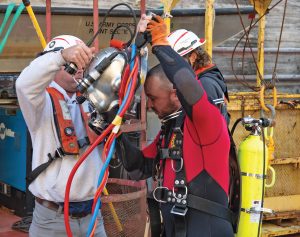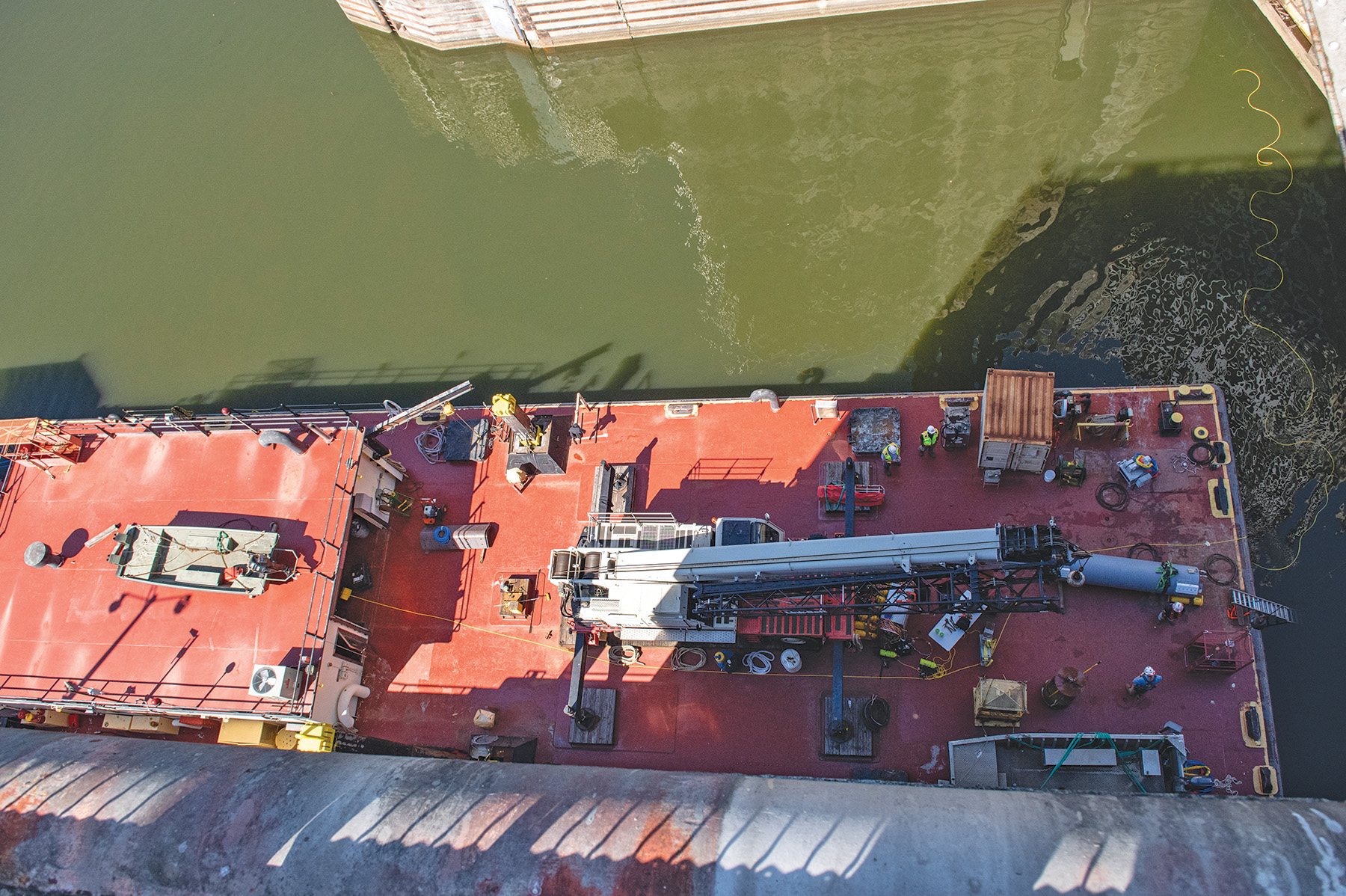Dive teams and remote-controlled vehicles have inspected the damage to both lower gates at Wilson Lock’s main chamber, and a team is on-site to begin slot repair work necessary before it can be dewatered.
Megan Simpson, maintenance section chief for the Nashville Engineer District, provided interested industry representatives with an update on the lock at Tennessee River Mile 259.4 in a conference call October 15.
Crews have not yet been able to determine whether the gates can be repaired or whether components might have to be replaced, she said, which makes a timeline for getting the lock back into service impossible to estimate. Dewatering is scheduled for mid-November to early December, at the earliest.
“There are cracks in the webbing in multiple locations on both the landside and the riverside of these castings,” she said. “There is also some cracking that was not noted in the 2022 dewatering that extends the width of the very bottom girder on the miter gate, near the pintle casting area.”
A remote-controlled vehicle from the Corps’ Engineer Research and Development Center in Vicksburg, Miss., was able to enter the chamber, along with a diving crew with a camera that could fit in spaces the ROV could not reach, Simpson said. They confirmed cracks in the gates’ pintle casting, which fits over the two pintle balls, on which the gates pivot.

Ty Melton, a lock mechanic with the Nashville Engineer District, dons diving headgear with the help of Matt Williamson, a fellow mechanic at Wilson Lock in Florence, Ala., on October 9. Dive-certified mechanics allow a firsthand look at any underwater maintenance concerns, such as the cracks in the land and river sides of the gates at Wilson that have caused the closure of the main chamber.
The Corps needs more information on how deep the cracks are and will not be able to determine the full extent of damage to the pintle casting until the chamber is dewatered, Simpson said. That will require jacking up the gate to get to the pintle casting. The Corps is checking to make sure that it has hydraulic jacks available to do the work, while also identifying any additional equipment that may be needed, Simpson said.
Additionally, she said, the steel will need to be tested to assess its overall strength, which will require removing a piece of the gate and having a third party conduct nondestructive testing.
To reduce pressure on the lower gates, they have been secured in an open position at the tailwater level, Simpson said. Instrumentation installed on the lock wall adjacent to the gates will be monitored at least monthly to check for movement. From an operational standpoint, the greatest concern is pressure on the gates when they open and close and when the chamber empties and fills, Simpson said.
Crews arrived October 15 and expected to begin work October 16 to repair the chamber’s caisson slot, necessary for dewatering it, Simpson said. That work is expected to continue into November. While that work is ongoing, the Corps is also refining its courses of action and drafting a repair plan.
“Right now we do not know without some further inspection in the dry about repairing vs. replacing on the pintle casting,” Simpson said. “We’re going to be looking into both options so we’re not going to be stalled and waiting for that dewatering of the lower end to do that.”
If the pintle casting has to be replaced, the lead time for traditional replacement is one year, Simpson said. However, the Corps is also investigating alternative means of fabrication.
“We’re tracking all possible resources and options on how to get the lock back in service as soon as possible and will have a strong monitoring plan after that,” Simpson said.
Nikki Berger, navigation program supervisor for the Tennessee Valley Authority (TVA), which owns the facility, said studies are ongoing to evaluate the gates at both Wilson and Pickwick locks to determine whether they should be rehabilitated or replaced in the future.
Daniel Rennaker, operations safety specialist in the Nashville District’s operations division, said, “It’s probably worth mentioning, obvious as it may be [with] that study for Wilson, we are doing everything we can do to accelerate that and go straight from study into design and into construction in case that becomes necessary and appropriate.”
When asked about available funding for repairs, Simpson said funding is available for the inspection and dewatering, “but as we move forward with our courses of action, we’ll have to see what that looks like and then communicate that up the chain.”
Vessels that can fit in the auxiliary lock at Wilson, which consists of two 60-foot by 300-foot chambers in sequence (much smaller than the main lock’s 110-foot by 600-foot single chamber), continue to use it. The Corps’ lock queue report showed an average delay at the lock of more than 53 hours for lockages over the last 24 hours as of the afternoon of October 17, with 18 vessels in queue, including some with 15 barges in tow. The auxiliary chamber can generally fit only one or perhaps two barges at a time, officials have said previously.
Cline Jones, executive director of the Tennessee River Valley Association, reminded those on the call that 41 pleasure craft have reserved slips for the Great American Loopers Association event at Wheeler State Park October 21-24 and would need to travel through Wilson Lock. Administrators at the lock said that would take some time because there were not as many floating mooring bits in the auxiliary chamber as in the main chamber and advised close coordination so that as many vessels could be locked through at one time as possible.
Cheatham Lock
Simpson also provided a brief update October 17 on Cheatham Lock at Cumberland River Mile 148.6, which reopened earlier that morning after closing the evening of October 14 due to issues with the hydraulic cylinder on lower gate machinery on the river side.
Simpson said interim repairs were made October 16 and tested October 17 before the reopening. Additionally, the Corps planned to install “air tuggers” that can be used to open and close the gates without the machinery, if needed. The Corps hopes to complete permanent repairs when the lock undergoes intermittent scheduled closures between March 10 and May 29 next year.
“At this point we’re doing everything we can to extend the life of the permanent repairs,” Simpson said.
She said it would be important, where possible, for industry to work together to reduce the number of lockages to lessen the strain on the machinery.
Cheatham Lock does not have an auxiliary chamber. The Corps’ lock queue report showed six vessels in queue as of the afternoon of October 17.
————
Featured photo caption: An aerial view of the ND-40, a maintenance barge belonging to the Nashville District, from the top of the main chamber at Wilson Lock. The barge serves as a base of operations for dive-certified district lock mechanics as well as operators of a Remotely-Operated Vehicle (ROV) visiting from the the Corps’ Engineer Research and Development Center (ERDC). The power cable connecting the ROV to the barge is visible in the upper-right corner of the photo. (Photos by Jeremy Croft/Nashville Engineer District)



